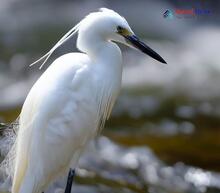The Egretta genus consists of a fascinating group of birds that captivate birdwatchers and nature enthusiasts alike. Known for their elegance and grace, these medium-sized herons have played a significant role in our understanding of avian evolution, taxonomy, morphology, and ecology. In this article, we will delve into the enchanting world of Egretta birds, their presence in Nepal, and their ecological significance.
Evolution Tree and Taxonomy
Belonging to the family Ardeidae and Order Pelecaniformes, the Egretta genus encompasses several species of herons known for their striking plumage. The Egretta genus is believed to have originated approximately 15 million years ago during the Miocene Epoch. Various species within this genus are distributed across the world's wetlands, showcasing an extensive evolutionary history.
Some well-known species from the Egretta genus include the Little Egret (Egretta garzetta), Great White Egret (Egretta alba), and Western Reef-Heron (Egretta gularis). Each species exhibits unique variations in size, coloration, habitat preferences, and foraging behaviors.
Morphology
Members of the Egretta genus display some distinctive morphological traits. These slender birds commonly possess long necks, beaks with sharp pointed tips for catching prey, long legs with curled toes for wading through water, and diverse feather colors such as pure white, blue-grey, or even dark grey.
A notable feature within this genus is their ornamental plumage; during the breeding season, these birds display long plumes called aigrettes on their backs or necks. This adornment aids in attracting mates and asserting dominance over other individuals during courtship rituals.
Ecology and Presence in Nepal
The wetlands of Nepal provide ample opportunity for Egretta species to thrive. Among them, the Little Egret and the Cattle Egret (Egretta ibis) are commonly found in this region. These birds inhabit a wide range of aquatic habitats, including rivers, lakes, swamps, marshes, and even rice paddies.
These elegant birds play a crucial role in their respective ecosystems. As predators, they help maintain the balance of prey populations by feeding on fish, amphibians, insects, and crustaceans. In turn, they act as an essential food source for larger predators such as raptors or carnivorous mammals.
Conservation efforts in Nepal have been instrumental in preserving the habitats and populations of Egretta species. The Chitwan National Park and Koshi Tappu Wildlife Reserve are prime examples of sanctuaries that ensure the continued presence and prosperity of these captivating birds.
In conclusion, the Egretta genus offers a fascinating insight into bird evolution and biodiversity. With a keen understanding of their taxonomy, morphology, and ecology, enthusiasts can further appreciate the presence of these elegant herons in Nepal. So the next time you find yourself exploring Nepalese wetlands, keep an eye out for these remarkable creatures gracefully wading through shallow waters.




